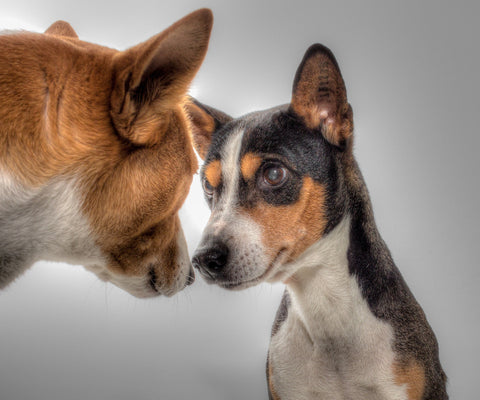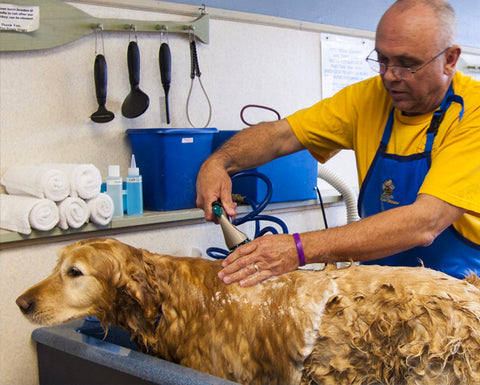
As professional dog groomers, it's crucial to be aware of the warning dog pain signs. By recognizing when a dog is experiencing discomfort or chronic pain, you can provide the necessary care and support to improve their well-being. Dog pain can manifest in various ways, and it's essential to be familiar with the signs so we can take prompt action.

In this article, we'll discuss ten common signs that a dog is in pain and how we can relieve pain in dogs. By being vigilant and observant, we can ensure the health and happiness of the dogs in our care.
It's essential to be able to identify when a dog is experiencing severe pain. In some cases, dogs will try to hide their discomfort from pet owners and strangers, and it's up to us to be vigilant and observe for any signs that they may be suffering.
10 Ten Warning Signs That a Dog Is in Pain
1. Changes in Behavior

Dogs in pain will often become more aggressive, anxious or defensive, or they may become more passive, lethargic, or inactive. Observe the dog's behavior closely to see if they seem more irritable or less engaged than usual.
2. Whining or Crying
Dog suffering will often express the discomfort through whining, crying, or yelping. Listen carefully when working with a dog and be alert to any sounds that seem out of the ordinary.
3. Loss of Appetite
Dogs in pain may lose their appetite, either because they are not feeling well, have acute pain or because they are not comfortable eating. If a dog is refusing to eat, it could be a sign that they are in pain.
4. Lameness or Limping
If a dog is limping, favoring one limb, or reluctant to bear weight on a limb, it could be one of the pain symptoms. Observe their gait and look for any signs of discomfort or difficulty.
5. Changes in Posture
Dogs in pain may adopt a different posture, such as hunching over, holding a limb in an awkward position, or guarding an area of their body. Watch for these signs, as they could indicate that a dog is in pain.

6. Panting
Dogs in pain may pant more frequently or heavily than usual. This could be a sign that they are in discomfort or that they are trying to cool down.
7. Restlessness
Dogs in pain may become restless or agitated, pacing or circling more frequently than usual. If a dog seems unable to get comfortable or settle down, it could be a sign that they are in pain.
8. Changes in Temperament
Dogs in pain may become more irritable or aggressive, or they may become more passive or withdrawn. Observe the dog's demeanor and look for changes that could indicate pain.
9. Loss of Interest in Activities
Dogs in pain may lose interest in their favorite activities or become less active. If a dog seems less interested in playing, exploring, or going for walks, it could be a sign that they are in pain.

10. Changes in Sleeping Habit
If dog feeling pain, they may experience changes in their sleeping habits. Dogs that are in pain might become more active during the night, when it's usually quiet and dark and they can move around without being noticed. They may also sleep for longer periods during the day as a way to find relief from the discomfort.
Some Example for Dog in Pain
- Limping
- Not Wanting to Be Touched
- Difficulty Exercising or Getting Up/Down the Stairs
- Pet’s Behavior That May Suggest Pain Such as Reduced Appetite, Depression, Restlessness and Aggression
If you observe any of these above warning signs, it's essential to take them seriously and seek veterinary care for the dog as soon as possible. In some cases, dogs may be suffering from a serious condition that requires immediate attention, and early diagnosis and treatment can improve their chances for a full recovery.
As professional dog groomers, it's also essential to be mindful of our techniques and to avoid causing pain or discomfort to the dogs in our care. Make sure to use proper equipment and techniques, such as a slow and gentle approach, and to be mindful of the dog's body language and vocalizations.
Knowing what to look for and being aware of the these obvious signs can help you ensure dog’s health and well-being.
If dog is showing even subtle signs of discomfort or pain it is important to take them to the vet as soon as possible. They can run tests, diagnose any underlying conditions that may be causing pain, and provide treatments to reduce or eliminate the dog’s discomfort. Taking steps early on to address your dog’s pain can help avoid long-term damage and keep your dog healthy for years.
Recommend your clients to visit the veterinarian for a professional opinion and treatment plan. Your vet may suggest using non-steroidal anti-inflammatory drugs (NSAIDs) to reduce inflammation and alleviate the dog's pain.
NSAIDS are a type of medication often prescribed for dogs in pain, as they work by blocking enzymes that cause inflammation. While effective, it’s important to remember these medications should be used only under the guidance of a veterinarian.
The vet should discuss any potential side effects and how to best administer them safely. By being familiar with dog pain signs and following vet’s advice, you can keep your dog healthy and comfortable. This content is for informational purposes only and does not constitute medical advice. Please consult with a veterinarian if you have any questions about dog treatment options.

FAQ:
What Should I Do if I Think Dog Is in Pain?
If you notice any of the dog's pain signs mentioned above, it is important to contact a veterinarian right away to determine the cause of the pain and address it as soon as possible. It is also important to take note of any behavioral changes that could indicate pain. Taking steps early on to address your dog’s pain can help avoid long-term damage and keep your dog healthy for years.

Can Dogs in Pain Can Be Groomed?
No, since grooming is always stressful to the dogs, it is better to postpone grooming session with clients that are in pain. Advise dog owner to see the vet, and only after receiving green light from the vet, you can proceed with grooming.
How Can I Tell if Dog Is Suffering?
There are several signs that may indicate a dog is suffering. These include changes in behavior, such as increased aggression or anxiety, changes in posture, such as hunching over or guarding a body part, and changes in activity levels, such as a loss of interest in activities they previously enjoyed. Whining or crying, lameness or limping, panting, restlessness, changes in sleeping habits, and loss of appetite can also indicate that a dog is in pain.
What Are the Warning Signs That Dog Is Crying for Help?
Dogs may vocalize their discomfort through whining, crying, or yelping. In addition, changes in behavior, posture, and activity levels can also indicate that a dog is in pain and crying for help. Observing the dog's behavior closely and being alert to any signs of discomfort or changes in their routine can help you identify when a dog may be suffering.
What Is Silent Pain in Dogs?
Silent pain in dogs refers to pain that is not accompanied by obvious physical signs or vocalizations. This type of pain can be more difficult to detect, but may still have a significant impact on the dog's quality of life. Changes in behavior, such as increased aggression or anxiety, changes in posture, and changes in activity levels can be indications of silent pain in dogs.
Will a Dog Sleep if in Pain?

Dogs in pain may have difficulty sleeping or may sleep more than usual. Observing changes in the dog's sleeping habits and looking for any changes that could indicate pain is crucial in helping identify when a dog may be suffering. If a dog is in pain, it's essential to seek veterinary care to provide them with the necessary support and care.
What Are Some Treatments for Dog Pain?
Treatments for dog pain will depend on the underlying cause of the pain, which vet can diagnose. Common treatments include medication, lifestyle changes such as exercise and diet adjustments, physical therapy or massage, acupuncture, laser therapy and cold or hot compresses. Depending on the severity of the dog's pain, your vet may also recommend surgery to address any underlying conditions that are causing discomfort.
What Need to Avoid When Dog Is in Pain?
When a dog is in pain, it's important to be aware of the signs and take appropriate action. First and foremost, dog owners should avoid trying to medicate their dog without consulting with a veterinarian.
This could lead to further complications or an improper diagnosis if the dog has an underlying illness that requires medical attention. Additionally, dog owners should avoid taking their dog for long walks or trips to dog parks if the dog is in pain, as too much activity can worsen existing injuries.

Finally, we should avoid handling dog too roughly, as this can increase the dog's discomfort and make it more difficult for them to recover. By being aware of the warning signs of dog pain and taking appropriate action, can help ensure their dog's comfort and recovery.
WHO IS PRIDE+GROOM?
The Very First Clean Beauty Brand…for Dogs!
PRIDE+GROOM is a female and minority owned all-natural pet grooming company born and bred in New York City. We designed our coat-specific dog shampoos with a light, fresh signature scent that says goodbye to the overwhelming fragrances currently in the dog grooming market. Our packaging and branding humanizes our pet products making them attractive and user friendly.
We offer wholesale pricing for professional use or resale, discover a wide range of premium pet care products, including the softest dog towels, effective dog bath brushes, and wholesale shampoo gallons for a squeaky clean finish at Pride and Groom Pro.
Our company is rooted in our love for dogs and cats, and we’ve put all our energy into creating products that let us care for them, their coats and their skin in a way that is natural, nurturing, and specific. Our formulas are a unique blend of essential oils sourced from around the world. Each ingredient has a purpose. Like Marshmallow Root Oil, in our Non-Shedder, helps detangle and nourish those dogs, like doodles, with hair that grows and is prone to matting.
PRIDE+GROOM is deeply committed to giving back to the community. We developed our ONE FUR ALL dog shampoo that we have donated to over 1000 shelters around the country. This amounts to over 50,000 needy rescue dogs getting the PRIDE+GROOM treatment before heading to their forever homes for adoption.



